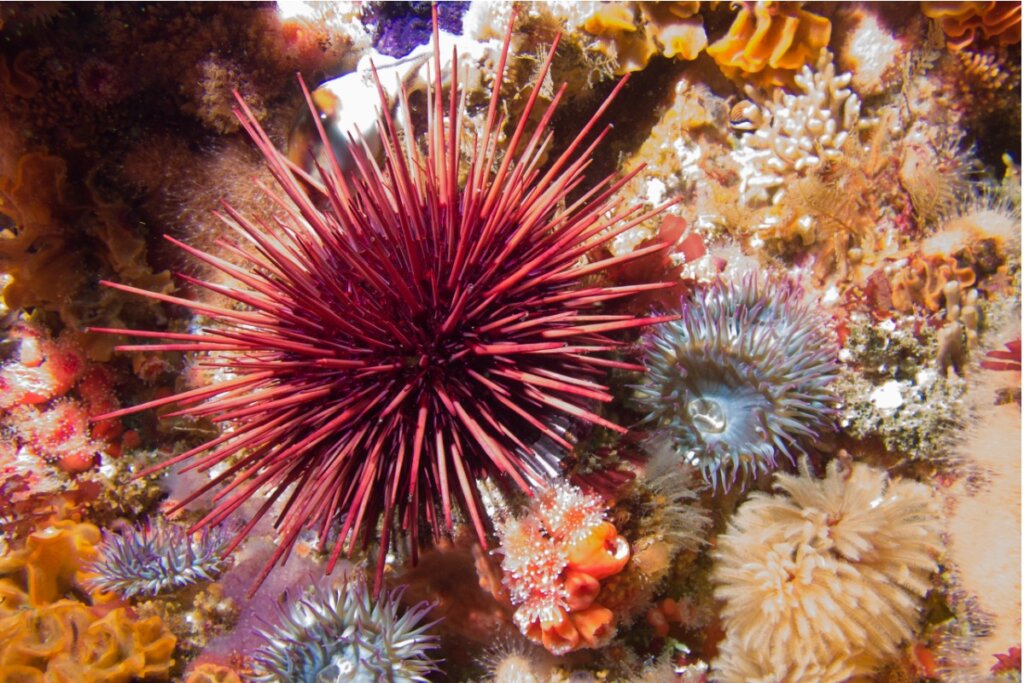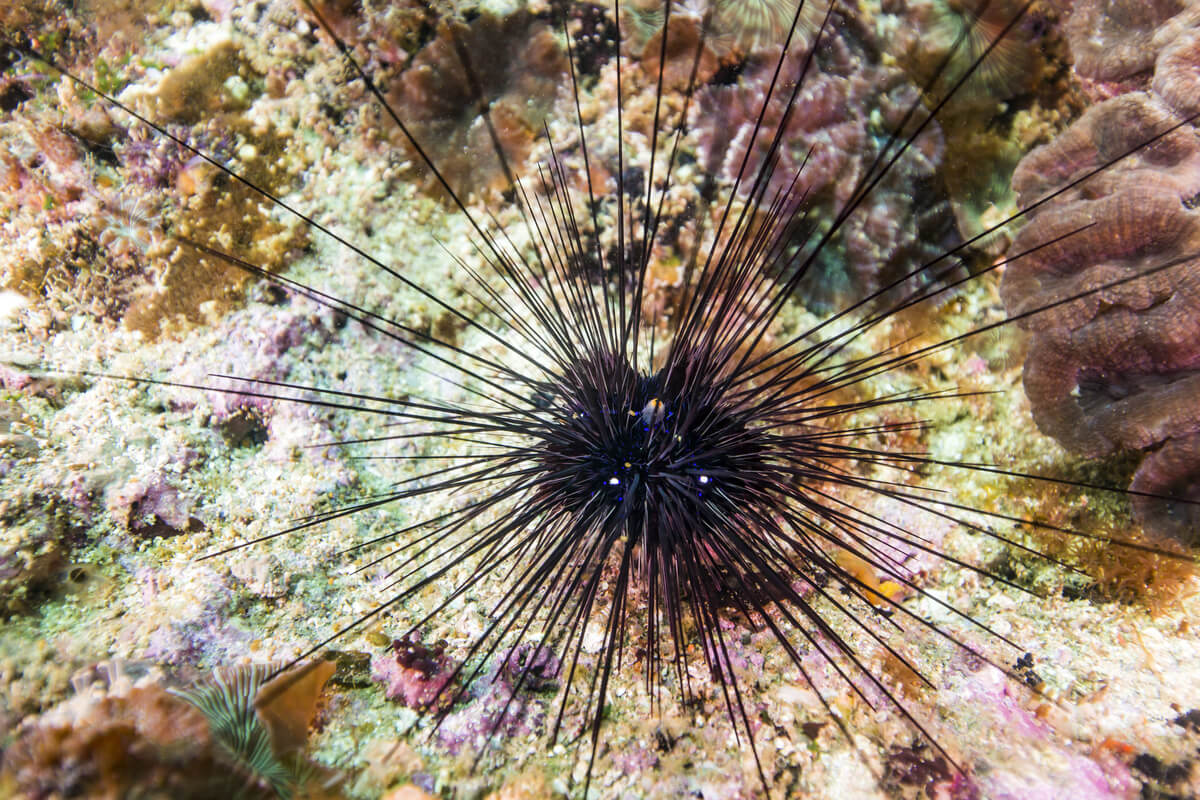What Do Sea Urchins Eat?

Sea urchins inhabit the seas of the world and are easy to see near the coast or in very shallow waters. The appearance of these creatures resembles a “porcupine”, as they have spines that surround them and which are their main method of defense. Because their shape isn’t very common, you may be wondering how sea urchins eat and what they eat.
These marine invertebrates belong to the Echinoidea class, in which there are more than 1000 registered species. Since they have no way to swim continuously, they just colonize the ground and move quite slowly. For this reason, there are great restrictions on the food they can consume. Read on and learn more about what these curious sea urchins eat.
What are sea urchins like?
These invertebrates have a round shape that resembles a balloon covered by a shell. The body is divided into two areas: an aboral (where all the spines are located) and the oral, which is the part where the mouth is. In other words, the shape of the sea urchin is a mass with only one opening, which faces the ground and is what makes up its mouth.
On the other hand, the internal part of this animal contains all its organs and makes use of water as a vascular system. The latter doesn’t mean that the water directly nourishes the urchin, but that it has a channel mechanism with which the blood flows as if it were blood.
Seen in another way, the water helps the urchin circulate nutrients through all its organs, something called the “aquifer vascular system.”

This same system is responsible for the movement of these echinoderms, because thanks to the hydraulic pressure that’s generated, they’re able to move their tube feet. Although it sounds strange, these limbs look similar to an elongated balloon that “inflates” or “deflates” as needed. In this way, they’re able to move on the ground and even obtain food.
In addition to this, the mouth of the sea urchin is composed of 5 strong jaws, fused in a device known as Aristotle’s lantern. This complex system is directly attached to the intestine, so it must be able to destroy all food before assimilating it. Furthermore, some species are capable of “projecting” their dentition, which is useful for digging, climbing, and gnawing.
What do sea urchins eat?
The diet of sea urchins is very varied and depends entirely on the species. Some focus their strategy on being herbivores, others on eating debris, and several more feed on the nutrients suspended in the water. Even so, most of these organisms prefer to use more than one nutritional adaptation.
Algae eaters
These invertebrates tend to devour marine vegetation, as they’re sessile and abundant beings. The beings most affected by their strategy are algae, as they can disappear in days due to the voracity of this animal’s intake. Macroalgae forests, one of the ecosystems with the most complex food chains, can be reduced to rocks by a few sea urchins.
In the case of specimens that usually dig, the burrows they build encourage the growth of algae on their walls. Thanks to this, they can easily “harvest” their food and even cause other organic remains to be stranded in their home.
A perfect example of this is Echinometra oblonga, a coral reef specimen that takes great advantage of the usefulness of its burrow.
Sea urchins that eat other animals
Although they aren’t that common, some sea urchins can feed on other animals. However, because they aren’t able to move fast, they need to focus their attention on sessile species such as sponges, corals, and clams. This doesn’t mean that they only consume animals, but that they have a preference for them; they can also feed on vegetation.
According to an article published in the Bulletin of Marine Science, sea urchins select their food not only for nutrients, but by choice. This study found that Eucidaris tribuloides, Lytechinus variegatus, and Echinometria lucunter have a strong preference for food of animal origin.
The most delicious isn’t always the most nutritious
In the same way as humans, it seems that some echinoids prefer the most succulent food to the ones with the best nutrients. This is easy to verify, because in several studies looking for the best food to raise sea urchins, it has been shown that algae are the food that provides them with the most nutrients.
The mentioned species prefer food of animal origin rather than algae. In some cases (as long as there are no predators nearby) they look for sponges or other organisms to feed on. For this reason, although they’re capable of eating a wide variety of things, they have well-defined tastes.
As you can see, some invertebrate animals are more complex than they appear at first glance. Although they represent one of the simplest groups in appearance, sea urchins can surprise you with their behavior. Without a doubt, nature will never cease to amaze us.
All cited sources were thoroughly reviewed by our team to ensure their quality, reliability, currency, and validity. The bibliography of this article was considered reliable and of academic or scientific accuracy.
- Kroh, A.; Mooi, R. (2021). World Echinoidea Database. http://www.marinespecies.org/echinoidea. doi:10.14284/355
- Tuya, F., Ortega-Borges, L., Del Rosario-Pinilla, A. B., & Haroun, R. J. (2006). Spatio-temporal variability in a key herbivore, the long-spined black sea urchin (Diadema antillarum, Echinodermata: Echinoidea) in the Canary Islands. Journal of the Marine Biological Association of the United Kingdom, 86(4), 791-797.
- Fernandez, C., & Boudouresque, C. F. (2000). Nutrition of the sea urchin Paracentrotus lividus (Echinodermata: Echinoidea) fed different artificial food. Marine Ecology Progress Series, 204, 131-141.
- Calva, L. G. (2002). Hábitos alimenticios de algunos equinodermos. Parte 2. Erizos de Mar y Pepinos de Mar. ContactoS, 47, 54-63.
- Cárcamo, P. F. (2015). Effects of food type and feeding frequency on the performance of early juveniles of the sea urchin Loxechinus albus (Echinodermata: Echinoidea): Implications for aquaculture and restocking. Aquaculture, 436, 172-178.
- Klinger, T. S., Lawrence, J. M., & Lawrence, A. L. (1994). Digestive characteristics of the sea‐urchin Lytechinus variegatus (Lamarck)(Echinodermata: Echinoidea) fed prepared feeds. Journal of the World Aquaculture Society, 25(4), 489-496.
- Spirlet, C., Grosjean, P., & Jangoux, M. (1998). Optimizing food distribution in closed-circuit cultivation of edible sea urchins (Paracentrotus lividus: Echinoidea). Aquatic living resources, 11(4), 273-277.
- McClanahan, T. R., & Shafir, S. H. (1990). Causes and consequences of sea urchin abundance and diversity in Kenyan coral reef lagoons. Oecologia, 83(3), 362-370.
- McClintock, J. B., Klinger, T. S., & Lawrence, J. M. (1982). Feeding preferences of echinoids for plant and animal food models. Bulletin of Marine Science, 32(1), 365-369.
- Obonaga, L. D., Zucconi, M. G., & Londoño-Cruz, E. (2017). Bioerosión por ramoneo en los arrecifes coralinos del Pacífico colombiano: el caso de Diadema mexicanum (Echinoidea: Diadematidae). Bull Mar Coast Res, 46, 41-54.
